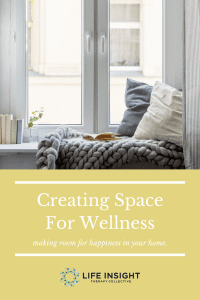Creating Space for Wellness
Cambridge Dictionary defines wellbeing as the state of being healthy and happy. Britannica defines happiness as a state of wellbeing. It seems that wellness and happiness are intertwined and dependent on each other to exist. So if we want to get happy, we probably need to seek wellness.
Wellness goes beyond physical health to include mental and spiritual health as important pieces of the equation. Although, it can be even more complex than that. Knowing this, it’s easy to assume exercise, nutrition, and good hygiene (physical health) combined with meditation, healthy relationships, and intellectual stimulation (mental health) and a clear conscience, deeper purpose to life, and harmony with yourself and the world around you (spiritual health) would create wellness. However, there’s one important piece missing from that list: a wellness space.
Your home has so many spaces that serve so many different purposes – all of them require a to-do list, cleaning schedule, and are generally active places. It’s important to create a space in your home that is just for recharging, self-reflection, and pursuing wellness. Wherever you set this up, it should be a spot that is only used to serve the purpose of being your retreat.
According to Lexico by Oxford, “hygge” refers to a quality of coziness and comfortable conviviality that engenders a feeling of contentment or well-being (it’s a Danish thing, go figure). Danes highly value “hyggekrog”, or wellness spaces, in their homes. A Danish hyggekrog often includes a picturesque window ledge with soft cushions, a blanket, candles, and a perpetually steaming cup of tea. Sounds downright cozy and like a perfect little nook for self-reflection and rest. But all wellness spaces don’t have to look quite so story-book perfect.
Think of this space as a reminder to practice your wellness habits. What does the space need in order to invite you in? How can this space work to separate you from other things happening in your life to offer a safe space for mental, physical, and spiritual well-being? It looks different for everyone, but all wellness spaces require a few key components. Let’s break them down:
- An Intention
Your wellness space should be a place away from goals and objectives. Set aside anything that causes stress, picture how you want the space to make you feel, and let that guide you in creating your space.
- The Right Location
Ask yourself what the purpose of your wellness space is. Do you need a tiny corner to meditate or journal? Do you need a clear open space to unroll a yoga mat? Perhaps art therapy is your thing, so you need a corner where you feel inspired and have space for your supplies. A wellness space can be an entire room or a yoga mat you unroll every day. Let the purpose of your space guide the location.
- Eliminate Distractions
In your wellness space, it is important for you to intentionally monotask. Removing to-do lists, clutter, and any other distractions is key to turning your practice into a habit. Only add elements or objects that are needed for the key task the space is created for. Eliminate all screens so your brain can truly focus. If you need music in your space, play it through a speaker and leave your phone in the other room.
- Nature Element
Natural elements in a space can create a soothing environment. Perhaps you can position yourself by a window with a view of a tree or garden, or hang a framed photo or print of plants or flowers. Bringing in a houseplant brings nature inside your space and has the added benefit of naturally purifying the air.
- Good Lighting
Again, positioning yourself by a window allows for beautiful natural light, and having a sheer curtain can help diffuse the light if it is too harsh. In a windowless space, or if you plan to use your space after dark, be sure to add some lamps with a nice warm light to create a sense of intimacy and calm.
- Incorporate all 5 Senses
Burning candles, using an oil diffuser, playing soft music, using a white noise machine, having mints or candy available, or brewing that steaming cup of hot tea are all great ways to bring all your senses into the experience to help you fully engage in your task of self-reflection.
Experts are learning more and more about how important wellness spaces in the home are. As a result, architects and designers are starting to consider wellness spaces an integral part of home building and design, but as we just learned, it doesn’t actually have to be a big or fancy space. Whether you create a full-on Danish hyggekrog or you find a corner to unroll your yoga mat every day, create a wellness space that meets your needs and allows you the space to grow mentally, physically, and spiritually well.
Join Our Community.
Sign up for our quarterly newsletter with practice news, timely resources, staff highlights, and other helpful tidbits!
Recent Posts







